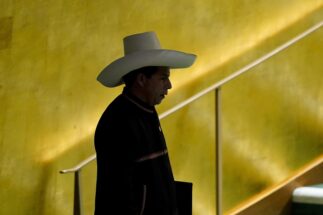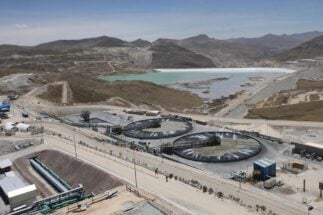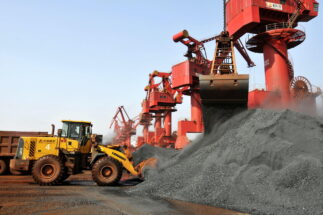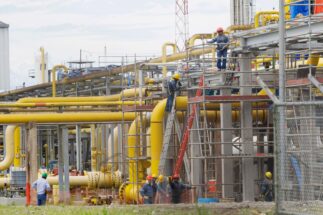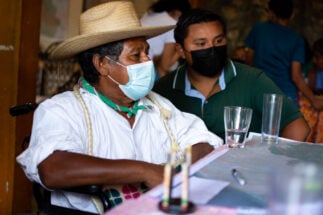In recent decades, Peru’s economy has stood out among its Latin American peers for its steady growth, and has been described as one of the best performers in the region. However, for many specialists, the performance of President Pedro Castillo’s much-criticised government could be jeopardising this stability, as well as foreign investment.
Between 1993 and 2019, Peru’s gross domestic product (GDP) grew at an average rate of 4.8% a year, and stayed reasonably consistent at 4.5% annually between 2010 and 2019, when the wider Latin American average was on the verge of a deficit. Peru even withstood the 2008 global financial crisis, the worst in recent decades: the year after its start, the South American country experienced a slowdown, but no deficit, with the growth rate at 1.1%.
4.5%
Peru’s average annual GDP growth rate between 2010 and 2019, a relatively consistent rate while wider Latin America verged on defecit
To a large extent, this resilience was due to the country’s macroeconomic policy, the foundations of which were laid in the 1990s. Two institutions were strengthened at that time: the Ministry of Economy and Finance (MEF) and the Central Reserve Bank (BCR). In both institutions – the former part of the executive and the latter autonomous – there has since been a continuity, in both its policies and its officials.
In the case of the BCR, its president is appointed by governments at the beginning of their term of office for a period of five years. Julio Velarde, current head of the BCR, has been in office since 2006 – something unheard of in a country as politically unstable as Peru. In 2015, The Banker magazine named him as its global Banker of the Year, and the best central banker in the Americas in 2020 and 2022.
But in stark contrast to its stable economic performance, Peruvian politics is in turmoil: five presidents have passed through the seemingly revolving door of the Government Palace in the last six years.
Afloat, but with mistrust
Despite the political problems, the Peruvian economy has remained afloat, with the exception of the first year of the Covid-19 pandemic, which did what not even the 2008 crisis could, in halting the period of consecutive growth that began in 1999. 2020, the year of Peru’s first deficit since 1998, saw the GDP growth rate fall by 11.1%.
Amid these circumstances, Pedro Castillo became president in July 2021. Formerly a rural school teacher, he won the election on a radical leftist campaign and by securing the anti-Fujimorism vote, of those opposed to controversial former president Alberto Fujimori (1990–2000) and his political ideology that has retained significant influence long after his time in office.
Castillo’s time in office has, however, been characterised more by a series of contradictory messages and bad decisions. In his first year, he has had to appoint more than 67 ministers in his cabinet, to nearly 20 different portfolios – a turnover unheard of even in a country as politically tumultuous as Peru. In addition, he has been accused of corruption, with the public prosecutor’s office opening several investigations for alleged crimes committed during his administration.

With Castillo in office, investor confidence has also decreased, translating into fewer possibilities for private investment from home and abroad. Currently, the business confidence index, published by the BCR every month, is at its lowest level since 2009, the time of the international financial crisis. In April 2022, expectations reached 40.26, a figure only surpassed in April and May 2020, the critical first two months of the pandemic.
In September 2021, a month after Castillo took office, credit rating agency Moody’s downgraded Peru’s rating from A3 to Baa1, signalling a warning over stability. The credit rating agency considered the country to have a “continuously polarised and fractured political environment”, leading to increased “political risk” and weakened policymaking capacity.
The BCR’s June inflation report indicates that private investment increased by just 0.8% in the first quarter of 2022, which represented the third consecutive half-year period of decline. In addition, the BCR shifted economic growth projection for 2022 downwards, from 3.4% to 3.1%. Similar estimates have been made by institutions such as the International Monetary Fund and the World Bank.
Elmer Cuba, an economist and former director of the BCR, indicates that the Peruvian economy “is still growing dynamically because it has a lot of momentum”. He points to a decision by congress earlier this year to approve the withdrawal of a percentage of the funds that formal workers have in the private pension system. He also highlights the upcoming start of production at the Quellaveco copper mine, the largest mining investment in the country (valued at US$5.5 billion), and the increasing return of tourists following reductions in numbers during the pandemic.
Due to these factors, Cuba estimates that Peru will grow according to projections. However, from his perspective, the country’s situation will worsen thereafter, as by 2023 it will no longer have the inertia of these circumstances. “Then the economy will start to suffer. […] There are no macro factors that make you think that next year will be better than this one,” he says.
This weak, populist government discourages investment
A national survey by Ipsos Peru, conducted in June, indicates that 75% believe that President Castillo is negatively affecting the economy and employment. Moreover, 79% of Peruvians say the economic situation is worse than it was a year ago.
This negative feeling is compounded by uncertainty. For Elmer Cuba, Castillo’s government “can be seen as a shock that we don’t know how long will last… it could last a year or five”, due to the opposition’s constant requests and proposals for the president to resign.
“His government is so weak and volatile, it gives confusing signals … You don’t know what to expect. And with the weakening that is being done to the state from within, it’s taking business expectations to their lowest levels,” he added.
An official consulted on the economic situation, who asked to remain anonymous, says it is very difficult to grow without the contribution of private investment, for which clear projections are needed to reassure investors that there will be no change in the rules of the game in the coming years.
“This feeling of a weak government, in which populist Castillo can radically change what he proposes, discourages investment,” they said. “If there is no investment there is no employment, and if there is no employment people do not generate resources, and if they do not generate resources there is no consumption, and if there is no consumption there is no growth. It becomes a vicious circle.”
The shrinking state apparatus
Jeffrey Radzinsky, a political analyst and director of the Grupo Fides Perú consultancy, believes that the country’s technocratic apparatus is facing its worst moment so far this century – not only because of the continual re-appointments of ministers, but also because of the weakening at different levels, including deputy ministers, directorates and lower-ranking officials. According to the aforementioned Ipsos survey, 76% believe that the ministers and officials chosen by Castillo are not honest or qualified.
A critical case has been the Ministry of Transport and Communications (MTC), the engine of public investment in the country. This ministry offers concessions to the private sector for large infrastructure works, such as airports, ports, roads or metro lines – projects that represent hundreds of millions of dollars in budget.

Newspapers in recent months have reported on an alleged mafia operating in the MTC to direct tenders, some allegedly linked to Chinese companies, which have been exposed by a collaborator of the justice system. For this case, the prosecutor’s office is investigating President Castillo, his nephews and former high-ranking officials such as Juan Silva, who was minister of the sector, and is currently on the run.
The MTC is one such portfolio that has seen a high turnover of officials due to poor appointments. One official stated that constant changes in a ministry such as the MTC have an impact on the institutional framework, leading to delays in the progress of major projects and loss of opportunity cost.
The problem is not confined to the MTC. In May, despite the looming global food crisis, Castillo appointed a person with no experience in the sector and who had previously been imprisoned as Minister of Agrarian Development. Social conflicts that the government failed to resolve quickly also affected the mining sector in recent months.
In its June report, the BCR attributes the drop in growth to 3.1% to lower production in primary sectors such as mining, due to the stoppage of important operations such as the Southern and Las Bambas mines, the latter operated by China’s MMG; and in agriculture, due to higher fertiliser prices. This translates into fewer exports and, therefore, less revenue for the state.
A third civil servant consulted emphasises the poor performance of ministries such as the MTC and of agrarian development, but also believes that in the wake of the pandemic, which has pushed some 3 million Peruvians back into poverty, people are calling for a larger state, because they have realised that they need better health and education systems, and labour protection. In Peru, the rate of employment informality is over 70%.
The problem, they add, is that the Peruvian state is too small by any standards (number of teachers or hospital beds per inhabitant, for example) and inefficient (it does not have a healthy civil service), which, the source believes, also limits economic growth. This is why they point out that “growth is not only achieved with private investment, but also with a good state”.
The civil servant does not believe that Castillo’s government will break the country’s macroeconomic paradigm, which is very solid, but it will affect the state apparatus in general. This, they say, will require reconstruction, but also an opportunity to make the economic reforms the country needs.
